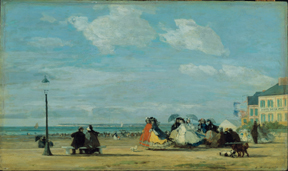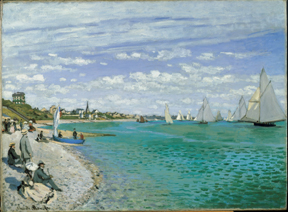
(845) 246-6944 ·
info@ArtTimesJournal.com
The Lure of the Ocean
 Eugène-Louis
Boudin Photo © Glasgow City Council (Museums) |
By INA COLE
ART TIMES September 2007
As two exhibitions
in the UK currently explore, the power of the sea to inform developments
in art has persisted vigorously through time. Impressionists by the
Sea, at the Royal Academy of Arts, London (to 30 September), which
then travels to the Phillips Collection, Washington DC (20 October –
13 January 08) focuses on how the Impressionists captured the transient
effects of weather and light on the coastline in the mid to late nineteenth
century. One hundred years later California rocked to the sounds of
Brian Wilson, the creative force behind The Beach Boys, now the subject
of an exhibition at Tate St Ives, Cornwall (to 23 September) aptly entitled
If Everybody had an Ocean.
Having lived by the sea for many years, I too became drawn to its unpredictable
behaviour; its wild omnipresence becomes embedded in the psyche, and
its innate dualism keeps one’s senses acutely tuned. Fascination with
the ocean as a relentless force in our consciousness has therefore understandably
recurred throughout art history: Its natural drama has inspired moral
and religious masterpieces; it has been the site of sacrifice and heroism,
and ultimately the rise and fall of nations. The ancient Greeks utilised
sea imagery in art, which can be traced back to 1600 BC, and in the
ninth to eleventh centuries AD, Scandinavian civilisations demonstrated
their reverence for the ocean through woodcarvings on their ships. An
early influence for French painting of the 1830s-40s were the stormy
seascapes of the seventeenth-century Dutch painters, who worked in a
country under continual threat from flooding, and in nineteenth-century
Japanese woodblock art, an important source of inspiration for the Impressionists,
the ocean’s power featured in the unforgettable images of Hokusai.
By the late nineteenth century artists were travelling between North America,
Scandinavia, Central Europe and the British Isles, and this internationalism,
or pursuit of the ‘other’, became the ultimate modern experience. Most
importantly, the railways had opened access to the channel coast, and
Parisians consequently flocked to the growing number of resorts. Impressionism,
with its anti-academic approach and interest in modern life, was a movement
immediately attracted to this new kind of existence. Identification
with a specific place, or particular way of life, was responsible for
the creation of many symbolically idealised communities, constructed
through mans’ inherent myth-making, which later became an important
facet in the development of twentieth-century modernism. Early glimpses
of this can be seen in Impressionists by the Sea
at the Royal Academy of Arts, which includes the work of Gustave Courbet,
Charles François Daubigny, Eugène Louis Gabriel Isabey, Edouard Manet,
Claude Monet and Pierre Auguste Renoir. The sea, as a subject, offered
an enticing opportunity to abandon tonal modelling and give emphasis
to the separation of coloured marks, with the brushstroke itself gaining
in independence. Billowing clouds, frothing waves, wind-tugged sails
and dappled light all offered the opportunity for spontaneous execution,
satisfying the Impressionist’s quest in developing a direct response
to nature.
 Claude
Monet The Metropolitan Museum of Art, Bequest of William
Church Osborn, 1951 (51.30.4) Photo © 1980 The Metropolitan Museum of Art |
In contrast, If Everybody had an Ocean utilises Brian Wilson’s music as a prism through which
to view developments in art and southern California from the 1960s.
This unusual relationship between music, art and cultural myth is appropriately
presented at Tate St Ives, a gallery situated by the sea in Cornwall,
in an area imbued with a particularly distinct artistic heritage; the
home of British modernism. This three-part exhibition explores the interplay
between avant-garde art and popular culture in relation to California
as a mythical youth-obsessed utopia; it then evolves to multi-coloured
abstractions that share an affinity with Wilson’s kaleidoscopic studio
productions, and lastly explores the dichotomy that exists between the
popular image of The Beach Boys and Wilson’s troubled inner world, also
focusing on the loss of innocence at the close of that revolutionary
decade. However, The Beach Boys were not part of the 1960s art world;
rather the exhibition reveals a counterfactual history of hidden connections
between art and music, exploring the parallel between the sound of the
Beach Boys and the art of southern California, and consequently British
pop artists; consumers of the American dream. If Everybody had an
Ocean is cleverly interjected with Wilson’s music and includes the
work of Peter Blake, John Cage, Vija Celmins, Thomas Demand, Liam Gillick,
Bridget Riley, Ed Ruscha and Fred Tomaselli.
Both exhibitions, in a sense, offer nostalgic visions of the past, focusing
on the coastal location as the creation of a kind of imagined utopia,
which has the power to bind a group together through their shared interests
and hedonistic activities. However, in reality the sea is a far from
ambient force. Although it can offer immense pleasure, particularly
as portrayed in the work of the Impressionists, its potential for devastation
is a force not to be ignored. In the twenty first century the power
of the ocean continues to burst into our consciousness, but this time
as a hostile force, as tidal waves and floods destroy lives and property.
One cannot help but reflect on a more sinister interpretation of its
power; that being the narrative of Noah’s Ark which, according to the
Book of Genesis, began with the higher orders observing mans’ destructive
behaviour, thereby deciding to flood the earth, destroying life in the
process; in other words, water used to devastating effect to express
a state of wrath. This narrative lives on as an eternal symbol of survival,
perfectly illustrating mans’ precarious smallness against the elements
of nature, and it is ultimately this battle, both psychological and
actual, that continues to manifest itself as a challenge to be conquered
in the work of artists.